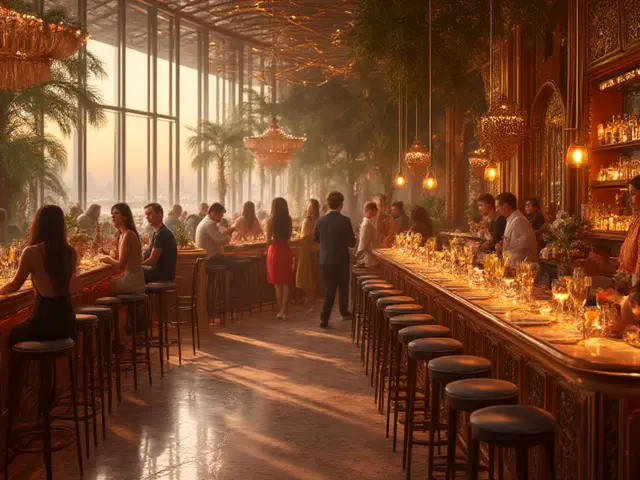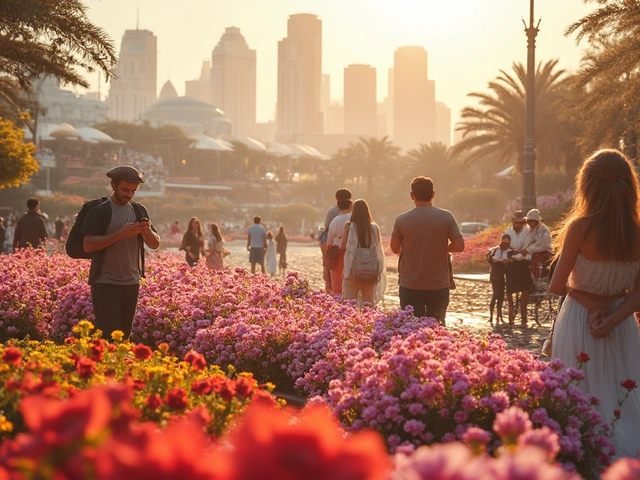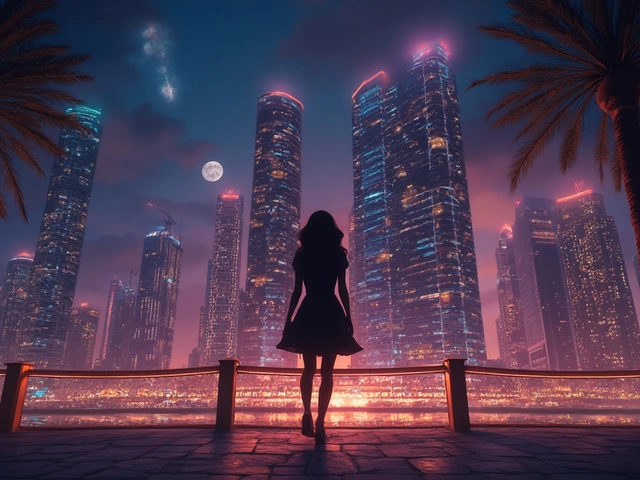Dubai’s skyline used to stand for excess, but now it’s turning heads for a completely different reason—its race toward sustainability. When you look up at the twisting Cayan Tower or marvel at the Burj Khalifa shimmering at sunset, there’s more than just architectural flair at play here. These buildings are part of a much bigger push: the green revolution reshaping the heart of the city. Dubai isn’t just aiming for environmental change out of obligation; it wants to set an example for the world, reflecting its commitment to sustainability in every layer of its urban makeup. Turning a desert oasis into a sustainable megacity? That’s not just impressive, it’s a real feat of innovation and determination. From solar-powered malls to lush rooftop gardens literally growing above Sheikh Zayed Road, let’s peel back the curtain on how Dubai’s most famous buildings are rewriting the rulebook for eco-friendly living. The city isn’t just dreaming green—it’s making it real, blending local traditions with the very latest tech along the way.
Iconic Landmarks Leading the Green Revolution
It goes without saying that Dubai’s landmarks are always in the spotlight, but did you know the Burj Khalifa has a secret weapon besides its dazzling height? This building uses a unique condensate collection system that captures moisture from the air-conditioning. Each year, that adds up to about 56 million liters of water—enough to fill 20 Olympic-sized pools. Instead of wasting it, the collected water feeds the building’s landscaping, keeping the greenery alive even in summer when the mercury touches 45°C.
Next door, the Dubai Frame isn’t just a photogenic tourist magnet. Its solar panels generate up to 82,000 kilowatt-hours of clean energy annually—enough to power over 40 Dubai villas. Solar panels on the roof blend seamlessly into the structure’s dazzling gold design, proving that ‘eco’ doesn’t have to look dull. The city’s latest pride, Museum of the Future, stands out not just for its shape but for its brains: it features an entire façade covered with insulated glass, high-efficiency LED lighting, and a sophisticated energy-saving system controlled by artificial intelligence. And—they mean business—Dubai Municipality committed that every single government building constructed since 2008 follows green building rules, pushing for LEED (Leadership in Energy and Environmental Design) certifications and other rigorous standards.
Sustainability in Dubai isn’t only about gigantic landmarks, though. The Sustainable City, on the outskirts of Dubai, is a living, breathing neighborhood designed from the ground up with eco-friendliness in mind. Around 500 villas make up this space, and the electricity demand is met through rooftop solar panels and energy-efficient insulation. Residents drive electric vehicles and use a community-wide biodigester to recycle organic waste into fertilizer for onsite vegetable gardens. With over 2,500 solar panels in total and shaded walkways that drop outdoor temperatures at least 6 degrees below the city average, the area feels like stepping a decade into the future. Shops in the Dubai Mall, the world’s largest, have even joined the green push: in 2023, it rolled out a mall-wide waste separation scheme in partnership with local startups to turn food scraps into energy via anaerobic digestion. Imagine sipping a coffee knowing your croissant crumbs are helping to power the mall’s cooling system!
Here’s a quick look at some of the most impressive eco-moves by Dubai’s iconic buildings, gathered in a handy table for quick reference:
| Building/Landmark | Green Innovation | Impact/Result |
|---|---|---|
| Burj Khalifa | Condensate water recycling | 56 million liters/year for landscaping |
| Dubai Frame | Solar panels | 82,000 kWh/year, powers 40+ villas |
| Museum of the Future | AI-led energy efficiency & insulated glass | Max efficiency, reduced CO₂ footprint |
| The Sustainable City | Solar-powered homes, electric vehicles | Net-zero energy living for 2,700+ residents |
| Dubai Mall | Waste-to-energy systems | Food waste fuels onsite energy production |
Does all this sustainability effort actually matter for residents and visitors? The answer is yes, and in ways that touch daily life. AC systems are smarter, meaning malls and homes use less power—so DEWA (Dubai Electricity and Water Authority) bills don’t sting so much. Rooftop gardens aren’t just pretty, they cool surrounding air and fight the ‘urban heat island’ effect. Next time you cool off in City Walk’s shaded boulevards, remember the pavement’s made from recycled rubber, cutting glare and keeping your feet happier during the summer sizzle.
How Dubai Adapts Sustainable Practices to Local Culture and Climate
Sustainable design in Dubai isn’t a copy-paste job from Europe or the US—it’s tailored to life on the Arabian Gulf. For starters, many new buildings blend time-tested Emirati architectural ideas with new tech. Think wind towers, or “barjeel,” used for centuries to channel cool breezes through homes. In modern times, look for barjeel-inspired ventilation in projects like the Deira Enrichment Project, where it pairs with solar shading and reflective materials to drive down cooling needs. Hard to imagine? Just picture a sleek high-rise borrowing airflow tricks from villas built before air conditioning even existed.
Dubai’s National Energy Strategy 2050 is all about balance: the city wants to mix 44% clean energy with its energy use by 2050, slashing CO₂ emissions and saving billions of dirhams along the way. Mohammed bin Rashid Al Maktoum Solar Park, already the world’s largest single-site solar project as of 2024, powers everything from government offices to the Dubai Metro Red Line. Being able to use locally generated renewable energy is crucial in a place where the sun is relentless—and where cooling eats up around 70% of all electricity usage every summer. Learn a lesson here: insulate your apartment’s windows, schedule AC for off-peak hours, and join every ‘green Dubai’ WhatsApp group you can find for tips—your wallet (and the planet) will thank you.
Local traditions pop up in unexpected ways. Instead of only glass facades, many buildings now use distinctive mashrabiya screens—these ornate, perforated panels filter sunlight and keep interiors cooler, reducing the need for heavy AC use. Even Dubai Opera’s wooden shell is sourced from certified sustainable forests in Finland! Newer projects, like the Expo City Dubai legacy district or the Mandarin Oriental Jumeira, are constantly rolling out green roofs, smart water recycling, and native desert landscaping that needs almost no irrigation.
Being sustainable is also about community. Residents around Business Bay swap apartment gardening tips for growing herbs on balconies (mint, coriander, and basil do great even in the July heat if watered at dusk and dawn). There are even eco-tours: Ras Al Khor Wildlife Sanctuary runs school visits to teach kids about Dubai’s natural wetlands, and they’re home to thousands of flamingos thanks to careful water management—proof that green thinking isn’t stuck inside glass towers.
Many local businesses join in—Carrefour and Spinneys encourage shoppers to use their own bags, discounting single-use plastic, and food delivery apps like Deliveroo partner with restaurants for compostable cutlery. Dubai International Airport (DXB) has rolled out paperless e-gates and solar-powered shuttle buses to cut emissions. Events like the Dubai Clean Energy Strategy Day or the Emirates Green Building Council’s annual awards, held in the autumn, offer networking for startups (and some truly clever green tech on display).
Practical Tips to Experience and Support Dubai’s Green Revolution
If you’re living or working in Dubai, supporting the city’s green revolution isn’t just about admiring shiny buildings. For starters, consider switching to DEWA’s Green Charger stations when you’re shopping for a new car—electric vehicles get free charging until 2026 and preferred parking in popular malls. Not ready for a full EV? Try a hybrid or use Dubai’s hyper-efficient Metro, which already offsets thousands of tons of carbon every year compared to private cars.
When picking a home or office, look for buildings with green ratings—Dubai has its own system, “Al Sa’fat,” ranking properties based on energy and water efficiency. Ask real estate agents for this rating; gold or platinum means better insulated walls, smarter AC, efficient lighting, and even greywater recycling. If you own or rent, simple upgrades help—switch to LED bulbs, install water aerators, and keep curtains drawn during midday heat to slash cooling bills. Most new rental contracts let you opt into green utility plans supporting DEWA’s renewable grid, so let your landlord know you care about sustainable Dubai, too.
Eating out? Choose restaurants in the Jumeirah area or at The Sustainable City that source their veggies from local hydroponic farms like Badia Farms. This slashes food miles and helps the city hit its goal for 75% locally sourced food by 2030. When shopping, look for UAE’s “EMIRATESQUALITYMARK” and “LOW CARBON” labels, which identify genuinely green products.
Want some hands-on involvement? Dubai holds frequent green clean-up days—Jumeirah Beach, Kite Beach, and Al Marmoom Desert Conservation Reserve run monthly volunteer events where residents sort and collect plastic waste, or help plant the local Ghaf tree, a drought-resistant species with deep roots in Emirati culture. The city even launched the Dubai Green List app, which maps eco-friendly stores, vegan cafés, electronic waste recycling stations, and the nearest shaded parks—try it, you’ll discover some hidden gems you never knew existed.
Schools are a big part of this green movement, too. GEMS Wellington and Dubai International Academy run student-led ‘green teams’ that compete every year to save the most energy and water—fostering eco-leaders for tomorrow. Even Dubai Parks and Resorts has joined in, refusing single-use plastics and running rides off solar power during low demand.
Let’s not pretend it’s always easy—the heat can feel relentless, and sustainable living sometimes means dealing with higher upfront costs. But the payoff? You get lower long-term bills, cleaner air (especially important during the humid months when dust storms kick up), and a city that’s literally growing greener with every year. For visitors, you’ll find more eco-friendly hotels than ever—think Al Maha Desert Resort using solar water heaters and offering conservation walks, or Atlantis, The Palm, recycling nearly 100% of its water. Many hotels now give loyalty points or discounts if you waive daily linen changes or use digital keys instead of plastic.
So yes, the sustainable Dubai dream is coming true. From expats growing tomatoes on balconies to Emirati families swapping plastic bottles for reusable jugs during Ramadan, everyone’s playing a role. And if you’re the curious type, take the tram to the Museum of the Future—not only is it an architectural wonder, but the interactive exhibits will give you fresh ideas to try at home. Dubai’s green revolution isn’t just a trend; it’s proof the city can rewrite its own rules on what’s possible, even when the desert heat is blazing outside.



